Y.S. Lee's Blog, page 4
June 21, 2016
Without apology
Hello, friends. I’ve not written a real blog post this week for various reasons (none of them tragic) and I’m not even going to apologize because look this view from the patio of Juniper Café:

The coffee beans are from Pilot, the cookie is magically both crisp and gooey, and the view makes you feel like you’re sitting on a cruise ship (with less environmental devastation).
School is nearly out, another round of houseguests are almost upon me, and words continue to pile up in my Opus. Life is sweet, both literally and figuratively. I hope the same is true for you, too.
Until next week!
June 14, 2016
Through trial and much error
A very long time ago, I read a story about how A. S. Byatt wrote her first novel. I could look it up* but I prefer the murkiness of what I think I remember: she was a bored faculty wife who wrote a novel with one hand while rocking the baby with the other. It’s a great story. The grit! The single-mindedness! The ability to rise above sleep-deprivation! Above all, it makes things sound so straightforward:
Step 1. Decide to write a novel.
Step 2. Write the novel.
Step 3. Send it (via a friend) to Cecil Day-Lewis, who will take you to lunch at a private member’s club in London. The rest is history.
But a lot of messiness has been edited from that story. Recently, I was chatting with some other writer parents and joked that I’d made a bunch of cardinal errors in working from home, so felt qualified to give expert advice on what NOT to do as a write-at-home parent. I’ve blogged about some of these challenges before (and have linked to the relevant posts below). But this seems like a good time to consolidate what I’ve learned.
Before I start laying down overconfident-sounding imperatives, I want to make it clear that even these are ideals to which I aspire. I screw up all the time, make silly decisions, get annoyed with myself. But when I’m working happily and efficiently and confidently – which is more and more of the time – here’s what it looks like.
This means saying a lot of quiet, consistent, regretless No’s. No dental appointments, no errands, no committee meetings (that one’s easy!) or impromptu coffee dates. No quick grocery stops. No taking phone calls from my mother, not even for just 10 minutes. No blog posts, even. My two- or three-hour blocks of writing time are purely for writing fiction. (I blogged about this last year with suggested scripts, if you want them.)
I have tunnel-vision/I leave the house.
Sure, it’s gross to sit at the kitchen table with breakfast dishes piled in an egg-crusted ziggurat by the sink. But I’ve learned, over and over and over again, that if I do the dishes, throw in a load of laundry, clean the bathroom sink and book that dentist’s appointment I keep forgetting to make, I’ll lose a whole hour. Then I’ll lose momentum. And then I’ll be furious with myself. An acquaintance described it as being your own bad boss, and she’s so right. When I assign myself tasks that fall outside the writer’s job description, I set myself up for failure.
I steal time.
I’m embarrassed to admit that this one took me a really long time to figure out. I used to start each work session by re-reading at least a scene or two, to get me back in the rhythm of my WIP. Only then would I start to think about where I was headed. Elapsed time: 20-30 minutes per session. I can’t bear to calculate how many hundreds of hours this adds up to, over my writing career.
A couple of years ago, I finally realized: I can steal time from the margins of other activities. Now, when I’m on my way to a writing session (getting the kids in the morning, walking to a café, making dinner), I’m already thinking about where I left off and where I need to go. I might block out a scene or sketch out some dialogue. This often goes best when I’m walking. Then, when I open my laptop, I’m already primed and ready to write.
I skip the slow parts.
I generally start at the beginning of a novel and write everything in the order I want it to be read. It works for me because I’m not a meticulous master plotter. In fact, my plots frequently wander/twist/swell in the most unexpected places, so it’s probably my most efficient process. Still, my current WIP has a frame narrative, and that means I’m already jumping around temporally. This has led to giving myself permission to skip spots where I might stall out (for me, these are scene openings and bridges) and go back to them once I’ve got the scene fleshed out. It’s working so far (although it still feels a bit like cheating).
This comes in two parts:
Sometimes, even with a lot of care and effort, a writing session feels like I’m trapped in a staring contest with the Opus. On those occasions, I’m trying to train myself to refer to a checklist with the extremely elegant title, “I’m stuck/tired/lethargic/don’t feel up to writing, WAAAAAH!” (It’s here, if you’re interested.) Basically, the goal is to ease up a little, analyze why I’m stuck, and then nurture myself in order to overcome the obstacle.
I also know a number of extremely talented, fast-writing novelists. If I ever compared my daily word counts to theirs, I would hurl myself into the abyss. I just don’t. (Or, real talk: I try really hard not to.)
I bend the rules.
I think this one’s mostly about temperament. I can live with rules but from time to time, I just have to break them. Lately, I’ve used some work time to have lunch with friends. It doesn’t happen often – maybe once a month. But it’s a terrific incentive to be extra-focused that morning, it rewards me with the company of people I really like, and it opens up my world a little wider. I am so much happier when I’ve made time to talk to an adult outside my family and, indirectly, it’s good for my writing.
I really hope this list doesn’t come across as smug or didactic. It’s just a few things I’ve learned through trial and much error, and I hope it’s useful to some of you. If you have observations or suggestions, please do share in the comments! I’m always hoping to learn from others.
—
*Here’s the story Byatt told in an interview in The Paris Review: “I had two small children, and in a slow and rather unhappy way, knowing that it was all inadequate, I rewrote and rewrote, with one or the other child in a little chair on the desk, rocking him with one hand.”
June 7, 2016
Bikes, bars and bloomers
Hello, friends. I am still learning to love cycling. (I’m getting better. I never dread it anymore. And sometimes, I really like it!) With that on my mind, here’s a post from my archives about when feminism met technology in the form of the bicycle.
—
In her Bicycle Book, Bella Bathurst quotes early American feminist Susan B. Anthony as saying, in 1896, “Let me tell you what I think of bicycling. I think it has done more for the emancipation of women than anything else in the world”. As Bathurst notes, “It was a surprising claim.”
The earliest bicycles were called velocipedes. They were mass-produced from 1857, but it took a hardy and determined cyclist to appreciate the ride they offered: velocipedes were built of wood, with the later addition of metal tires. When pedalled over patchily paved roads, it’s no wonder they became known as “boneshakers”. The velocipede evolved into the penny-farthing bicycle of the 1870s, with its enormous front wheel. Gears had yet to be invented, so the big wheel enabled the cyclist to ride quickly while pedalling at a reasonable rate. It also improved the ride quality.
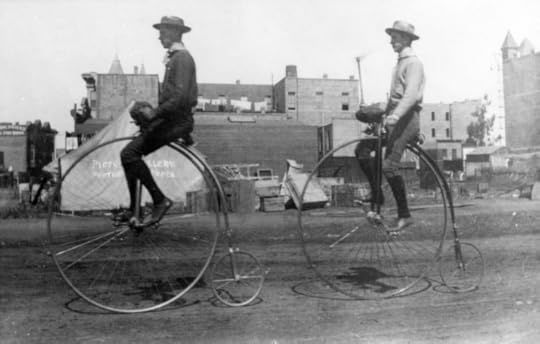 Two men on pennyfarthings, California, 1866. Image via wikipedia.
Two men on pennyfarthings, California, 1866. Image via wikipedia.However, women of the 1870s were still trapped in highly structured skirts with bustles – possibly an improvement over the huge crinoline of the 1860s, but still terribly cumbersome and constricting.
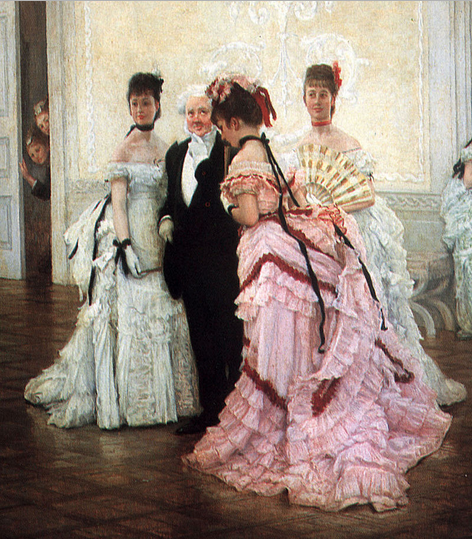 Detail from “Too Early”, by Tissot. Image via wikipedia.
Detail from “Too Early”, by Tissot. Image via wikipedia.It’s impossible to think of athletic activity in such clothing, or even what we now consider a normal range of motion. Contrast the lines of Tissot’s gowns (above) with this contemporary instructional video, which shows how tricky it is to mount and dismount a pennyfarthing.
Some women of means briefly considered the tricycle. According to Bathurst, “While out in her carriage one day at Osborne, Queen Victoria spotted a lady on a trike at a distance. Intrigued, she ordered her driver to speed up. The trike rider looked round, realised who her pursuer was, panicked and took off. Sadly, the Queen did not succumb to the temptation to give chase. Instead, she asked to meet the trike’s inventor, James Starley… [and] was pleased enough with the trike to order two. Even so, trike fever never really caught on. Not because there was anything inherently wrong with them, but because the bicycle was better.” It was only with the invention of the safety bicycle in the late 1880s that women began to embrace the machine.
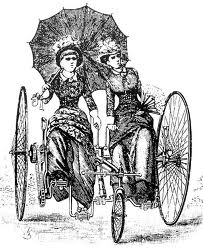 A tandem tricycle, 1882. Image via the Women’s History Network.
A tandem tricycle, 1882. Image via the Women’s History Network.With the safety bicycle came an immediate and predictable public uproar at the spectre of ladies sitting astride a bike, revealing the existence of legs and possibly damaging the “feminine organs of matrimonial necessity” (quoted in Bathurst)! And there was the very real problem of riding whilst wearing a corset and some 20 pounds’ worth of clothing. It was at this moment that cyclists and clothing reformers found common cause.
 “Ladies safety bicycle” from 1889. Image via wikipedia.
“Ladies safety bicycle” from 1889. Image via wikipedia.Bloomers had been worn – and ridiculed – since their invention in 1851, by the American activist Elizabeth Smith Miller. It required huge confidence to wear bloomers in public: even Amelia Bloomer, who lent her name to the garments, had given up on bloomers by 1859 in favour of undergarment reform. Despite the founding of the Rational Dress Society in 1881, the wearing of bloomers or rational dress (ample trousers overlaid with a shorter skirt) was still considered eccentric and even morally suspect.
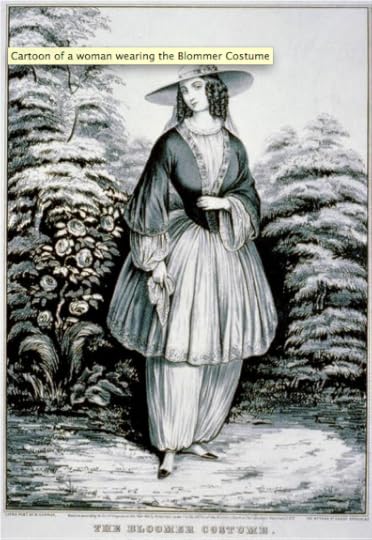 Woman in Bloomer Costume. Image via the National Park Service.
Woman in Bloomer Costume. Image via the National Park Service.For example, dress reformer and bicycle enthusiast Lady Harberton was refused service in the ladies’ lounge of the Hautboy Hotel in Surrey on the grounds that she was wearing bloomers. She was directed to the bar, where the only other women were prostitutes. When Lady Harberton sued the hotel, the jury found in favour of the landlady.
Despite such setbacks, the bicycle offered just the necessary incentive for the rational dress movement to stick. Bathurst quotes Rose Macaulay’s description of the sensation of bicycling as “glorious; the nearest approach to wings permitted to man and woman here below”. Speed, independence, and the sensation of flying?
In the long run, the bustle didn’t stand a chance.
May 31, 2016
In further praise of…
Hello, friends. A fortnight ago, I blogged about three YA/children’s novels I recently read and loved. This week, I want to highlight three more.
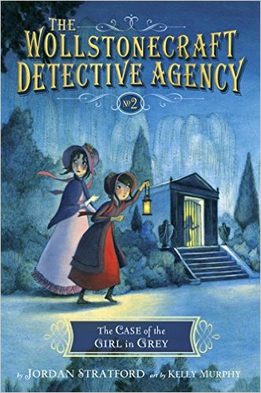
What if Mary Shelley and Ada Lovelace had been children together, and friends? What if they’d solved crimes assisted by their tutor, “Peebs” Shelley, with occasional appearances by the young bookworm Charles Dickens? This is the premise for Jordan Stratford’s the Wollstonecraft Detective Agency series. Sticklers for historical precision, beware: Stratford very deliberately (and thoughtfully) plays with historical timelines (and rescues, for no particular reason except that of compassion, little Allegra Byron from her neglect and early death in an Italian convent). But he’s faithful to the spirit of the age, his prose is lively yet restrained, The Case of the Girl in Grey crackles with energy, and as the title suggests, it’s an homage to Wilkie Collins’s The Woman in White. I love it.
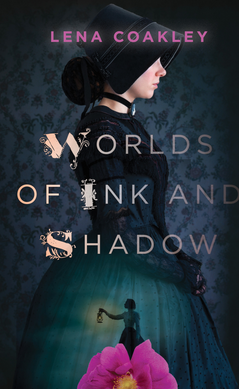
Before I started Worlds of Ink and Shadow, I was verrrrrry leery of the idea of a fantasy based on the Brontë siblings’ juvenilia. (I’ve always been appalled by Branwell’s profligacy in light of his sisters’ privations, and worried that Anne was maybe too much of an enigma to understand.) I am so delighted to report that Lena Coakley has found an absolutely marvellous, fingertip-tingling route into the Brontës’ joint imaginary world. The sibling relationships between the four are fierce and moving; they feel absolutely true. And the points at which the fantasy is grafted onto historical fact are so careful and respectful, while being also quite unexpected. There’s also affectionate humour, here – not something one expects from the Brontës’ world, but which lightens and broadens the novel in subtle and crucial ways. Worlds of Ink and Shadow is astonishing in the way it makes the already vivid Brontë siblings feel even more real.
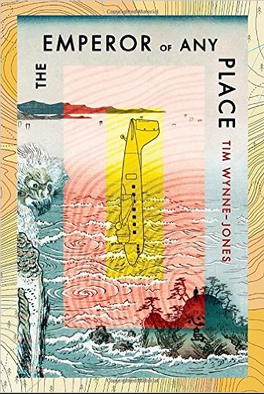
Oh, I felt a deep stab of panic when I first picked up The Emperor of Any Place. I just happen to be writing a novel set in Southeast Asia during the Second World War and was horrified to realize that Tim Wynne-Jones has just published one. (I didn’t even have the brief, petty consolation of hoping it would be a bad novel. I’ve read enough TWJ to know that’s not going to happen! Anyway, all is well: The Emperor of Any Place is utterly different from the novel I’m writing and I know there is space enough for both books to co-exist.) And I’m so very glad, because The Emperor of Any Place is wonderful. It’s set in present-day suburban Toronto (“Any Place”) and includes substantial excerpts from a diary kept in 1945 by a Japanese soldier marooned on a Pacific island. It’s funny and extremely well-observed (“a loaf of dirty-blond hair”) and also terrifying and deeply moving. It’s grounded in so many specific, heavy-realist details and yet has a minor fantasy element that feels entirely convincing and necessary. I have a minor quibble about teenaged behaviour (would 17yos go to McDonald’s on a first date, and would they hold hands across the table before they’ve decided whether they really like each other?) but apart from that, I’ve been very enjoyably haunted by this unusual ghost story.
Up next: I’m taking a break from YA to read Lindy West’s Shrill and Stephanie Burgis’s Masks and Shadows!
May 24, 2016
Gardening days
Q: In a room full of international citizens, how might you ferret out the Canadians?
A: Ask the date of Queen Victoria’s birthday!
In a strange but probably harmless historical twist, we are the only country in the world to celebrate the birth of Victoria of England (1837-1901), which falls on May 24. Presumably, Canadians really feel the need for a holiday in May and are happy to snatch at the flimsiest of excuses.
In truth, we don’t spend much time thinking about QV. When I was younger, my friends and I celebrated “May two-four”, which coincidentally describes the number of cans in a case of cheap beer. Now that I’ve become more discerning about beer, it’s our gardening weekend. After a long winter and a reluctant spring, it was pure joy to take our seedlings outside.
My Mother’s Day gift: blackberries every year! We still haven’t found the right spot to plant this, but I’m really looking forward to watching it grow over time.

19 tomato seedlings plus one basil seedling in the soil, and a few more that need homes.

Our strawberry bed in its fourth year. It’s hard to see in the photo but we have netting stretched over the whole bed and tucked in at the sides, to keep out the strawberry thieves. The first year we didn’t do this and ended up with exactly half a strawberry. The rest went to chipmunks, squirrels and birds.

The first (unripe) cherry tomato! We’ve had such a late start this year.

Creeping phlox. I love its tiny precision.

Gratuitous dog shot! Mac is loving the warm weather and spends hours mooching around the garden and napping in patches of sun and shade.

(Do excuse the grass. We’re thinking of seeding that dead area with thyme or clover, since we have zero interest in traditional lawn maintenance.)
How did you spend the past few days?
May 17, 2016
In praise of…
Hello, friends. I’ve been reading for a Top Secret Project (I’ll tell you more about it in a few months) and it has been both a revelation and a delight. This week and next, I thought I’d share some of the books I’ve most enjoyed so far. These aren’t reviews, in the traditional sense, but I wholeheartedly recommend all these books.
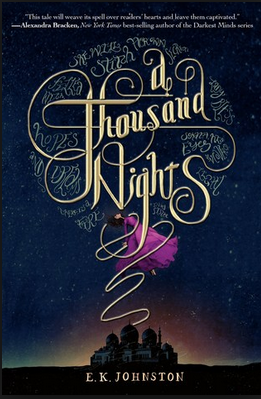
You may remember how much I love and admire E K Johnston’s first two novels, The Story of Owen, and its sequel, Prairie Fire: epics of modest Canadian heroism packed with sly wit and heartbreak. A Thousand Nights couldn’t be more different – it’s a re-imagining of The Arabian Nights – yet it crackles with what I’m learning to recognize as Johnston’s utter confidence as a storyteller. The setting is vivid and detailed, the unnamed narrator courageous and insightful. While the dénouement feels somewhat compressed, the novel continually circles around ideas of storytelling and power in a way that I find hypnotic.
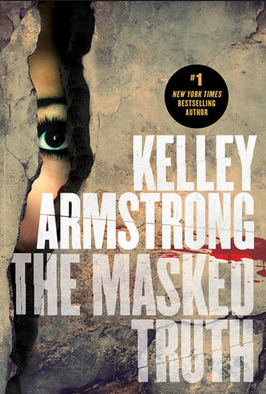
I have always admired Kelley Armstrong’s gift for grabbing you by the neck and dragging you deep into a story. That’s a violent metaphor but an apt one for Armstrong: I always feel a little bruised and unsettled by her imagination, and The Masked Truth is the most terrifying book of hers I’ve yet read. (If you’re sensitive to horror fiction, don’t read it before bed. I made that mistake.) Yet The Masked Truth is much more than a slick, pacy story about a hostage situation gone badly wrong. Both its protagonists suffer mentally: Riley from PTSD and Max from schizophrenia. Max’s illness, in particular, is handled with sensitivity while multiplying the horror of the premise. And while the dénouement seems a bit improbable, the resolution a little too smooth and tidy, I am so grateful for a happy ending. I really believe in Riley and Max and would have been heartbroken by too much harsh realism after all they suffer.
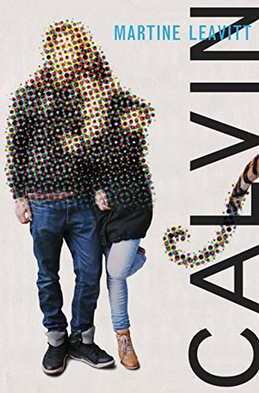
I read Martine Leavitt’s Calvin soon after The Masked Truth without realizing that both feature protagonists who suffer from schizophrenia. It’s an instructive contrast because the novels are so different, yet both follow brilliant young men dealing with diagnoses of schizophrenia while falling in love with fiercely intelligent young women. Calvin is built, rather elaborately, around the protagonist’s overidentification with Bill Watterson’s Calvin and Hobbes comics. I usually mistrust extended conceits but this one worked for me. The heart of the book – the parts that I adore – were the conversations between Calvin and Susie (see? There’s that conceit popping up again). They’re plausibly teenaged-metaphysical, yet far more beautiful and insightful and uncompromising than I ever managed to be as a young person. (Maybe the reason I admire this book so much is that I wish I’d read it as a teenager. Then again, it might have been dangerous to set my lifetime standards for meaningful conversation so dizzyingly high.) The ending – today is apparently my day to complain about endings that don’t quite match the very high standard of the beginning and middle – is slightly disappointing in its rosy tidiness. Still, it’s an extremely fine novel and I was deeply excited and awed by Leavitt’s craft.
*Aside: are there any books about a brilliant girl who’s diagnosed with mental illness? It’s probably just the cumulative effect of reading two novels about brilliant schizophrenic boys/girls who love them and dispense patient life wisdom, but I’d be interested in seeing someone undercut that gendered nurturing dynamic. It’s disconcerting to have both Riley and Susie – otherwise feminists and independent thinkers – conclude, “I love him and he needs me so.”
Have you read anything particularly fine lately? Do tell, if you have!
May 10, 2016
“May I be excused? My brain is full.”
Q: Guess what I learned this week?
A: Harold Bloom‘s brain is full, the world is doomed, and it’s mostly J K Rowling’s fault! Or maybe just one of the three.
Here’s what I mean:

In case you can’t read the photo, it says:
Hans Christian Andersen, in aesthetic eminence, is comparable to Dickens and the later Tolstoy. In the cultural dumbing-down represented by the Harry Potter phenomenon, adults and children alike need the actual Andersen, here made brilliantly available by the Franks.
— Harold Bloom, editor of Stories and Poems for Extremely Intelligent Children of All Ages
This is Bloom’s blurb for Diana Crone Frank and Jeffrey Frank’s translation of The Stories of Hans Christian Andersen (2003). It’s one of just two blurbs offered (the other is from Garrison Keillor) and it takes pride of place at the centre of the back cover.
As a blurb, it’s a failure: it’s built around vague hand-wringing and a gratuitous insult. It says almost nothing about the Franks’ work in selecting, translating and editing the fairy tales. And it certainly doesn’t move me to buy the book. Mostly, it makes me think of that Far Side cartoon from the ’80s: a student asking, “May I be excused? My brain is full.” I’m surprised that someone whose job is critical thinking could fall victim to this kind of cultural siege mentality.
I’m now going to stop talking specifically about Harold Bloom and look more generally about the anxiety that surrounds popular books. “Cultural dumbing-down” is a hoary old complaint. For as long as the concept of culture has existed, people – frequently but not always elderly – have hoisted their pants up to their armpits and griped about how the world used to be kinder, smarter, more ethical, more spiritual, and just generally better than it is now. Plus ça change, plus c’est la même chose, hein? The problem with complaints about “cultural dumbing down”, though, is that they presuppose a few things that really don’t stand up to scrutiny:
Assumption 1. The literary canon is full and we’re operating a strict one in/one out policy from here on in. If we admit something less worthy (however we choose to define that), we’re devaluing the whole collection.
Obviously, this is impossible. Artistic production isn’t going to end in 10, 9, 8, 7… So where and when will we draw our boundaries? And what kind of art are we going to permit? The literary canon shouldn’t be a sacred temple where Great Works gather dust. And fortunately, it’s not. It’s evolving all the time. (It used to be a bunch of white men plus Virginia Woolf. And while it’s still extremely – shall we say – homogeneous, things are starting to change.) This doesn’t mean the sky is falling; it means that new kinds of readers are asking new kinds of questions.
Assumption 2. We all need (original emphasis) the same things because we all share the same values and experiences.
This is closely tied to the idea of a canon and the way a certain kind of reader presumes a certain kind of canon. In fact, my canon is going to look different from your canon, dear reader, and again, that’s just fine. What really matters is that we’re curious, critical and careful readers who notice different things and discuss them with verve and courtesy. I love the stories of H C Andersen but can well imagine a time when I might need them less than some decidedly non-canonical work.
Assumption 3. Popular art is rubbish.
People who conflate “popular” and “bad” are a forgetful bunch. Dickens was wildly popular and his fiction is built on populist themes and interests. (To give just one example, Oliver Twist belongs to the subgenre of the Newgate novel – the Victorian equivalent of true-crime.) Fantasy writing is often dismissed as sub-literary, yet Tolkien regularly discussed his works-in-progress with C S Lewis and a few other friends. If it comes to that, Hans Christian Andersen was loved and celebrated in his lifetime, both in Denmark and abroad. Popularity is not the problem here. Bad art certainly exists, but that’s a different conversation.
In conclusion, I’ll remind you of the Edinburgh Review‘s assessment of Wordsworth’s “The Excursion”, from 1814. It begins with the words, “This will never do.” Can you imagine? The condescension! The siege mentality!
Oh, my dears. That will never do.
P. S. As I mentioned in a previous post, I’m reading Andersen in two different translations right now, trying to figure out which to buy for my children. The Franks’ translation is really energetic and colloquially American, while the Nunnally translation is more formal while still wonderfully vivid. I’m leaning towards the Nunnally edition because of how beautiful the language is.
May 3, 2016
4 snippets from Rivals in the City
Hello, friends! There are a few days left to enter to win a full set of the Agency mysteries. Here are the links:
The giveaway at Read Now, Sleep Later
The contest at the Hiding Spot
Good luck!

Today, I’m sharing with you four quotations from Rivals in the City. I like the way they emphasize the story’s various strands and concerns.
“This is my first taste of true independence, the closest I’ll ever come to perfect freedom.”
“We’ve waded through sewers, dangled from a bell tower, and stumbled out of a burning building together. Can you top that?”
“Possibly.”
“Mary swung around to face him, taking both his hands and halting him midstep. ‘James Easton, I am fervently, passionately, utterly, scandalously in love with you.’”
And, my personal favourite:
“They looked precisely like what they were: a courting couple taking the air of a late morning. They also looked nothing like what they were: a pair of radicals, quietly at war with their society.”
I loved writing about Mary Quinn and feel very sorry that time is past. But I’m glad her adventures continue with this reissue from Candlewick Press! If you don’t already know her, I hope you will.
April 26, 2016
Confetti and contests
Hello, friends. This week, the Agency novels are once more bursting forth into the world, dressed in their new, super-atmospheric covers! To mark the occasion, I’ve written a brief guest post and my generous publisher, Candlewick Press, is sponsoring separate giveaways at each of the following blogs.
Click to read each post and hopefully win a full set of the Agency novels:
Four Victorian novels that changed the way I thought about the period at Read Now, Sleep Later
Four inspirations for the Agency at the Hiding Spot
Four things the Agency is (apart from historical mysteries about girl detectives) at YA Book Nerd
Best of luck and happy reading!
April 19, 2016
Scandal & superheroes
Hello, friends. On April 26, Candlewick Press will be reissuing all four Agency novels in super-atmospheric new covers. There will be a mini blog tour and some giveaways (hurrah!), and I’m feeling pretty verklempt about the whole thing. I am so grateful that the amazing people at Candlewick remain 1000% behind my books.
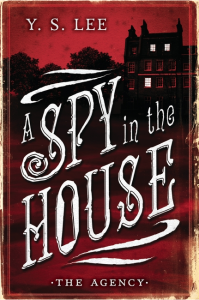
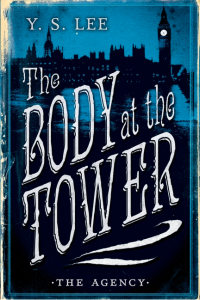
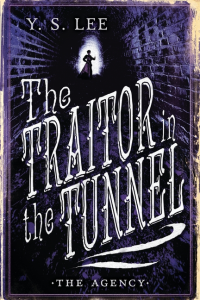
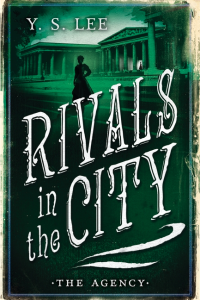
I adore the new covers (which are closely based on the amazing UK covers designed by Walker Books). And I’m so very excited to know that new readers will soon meet Mary Quinn.
I’ve been thinking, recently, about Mary Quinn’s literary origins. I’ve written a little about them in the past and will talk about them more next week, during the blog tour. But today, I realized there are two more books – one Victorian, one contemporary – that also nourished the idea of a mixed-race girl detective in Victorian London.
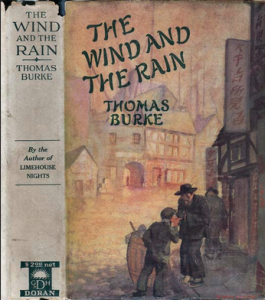 Note the Chinese lettering on the sign. East London was badly damaged by the Blitz, so this kind of streetscape no longer exists in Limehouse.
Note the Chinese lettering on the sign. East London was badly damaged by the Blitz, so this kind of streetscape no longer exists in Limehouse.In many ways, the Agency series is the child (children?) of my doctoral thesis. While I was scouring the British Library for autobiographies of working-class men, I ran across a book called The Wind and the Rain: A Book of Confessions by Thomas Burke. The Wind and the Rain purports to be a memoir by Burke, a successful author who published several books between 1915 and 1937. He was the first to write about the Chinese population in London’s East End. In fact, doing so made his reputation.
I soon discovered that The Wind and the Rain was at least partly fictionalized, but by that time I’d already read it. It’s incredibly vivid: nearly all Chinese people in London lived in the communities of Limehouse and Poplar, and Burke knows firsthand the smells of a Chinese herbalist’s shop. While I couldn’t use Burke’s “memoir” in my dissertation, I was already haunted by his (scandal-pandering, sensationalist, Orientalist) depictions of the London Chinese community.
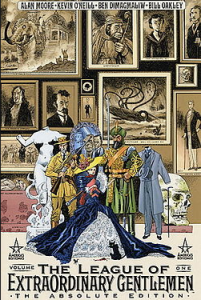 Burke wrote more than once about a character called Quong Lee, who owns a herbalist’s shop in Poplar. So imagine my surprise when Quong Lee turned up as a character in Alan Moore and Kevin O’Neill’s mostly excellent graphic novel, The League of Extraordinary Gentlemen, vol. 1 (not to be confused with the very forgettable movie adaptation)! The Limehouse scenes in The League are astonishing and squalid – a pretty straight and uncritical use of Burke’s lurid depiction of the thrills and dangers of the Orient. Still, I was intrigued to find them there at all. This is a London that very few others have bothered to write about. Do I wish Moore had written them with more nuance? Obviously. But crude as they are, the mere existence of those scenes starts a conversation. It creates a space for other writers to jump in. Writers like me.
Burke wrote more than once about a character called Quong Lee, who owns a herbalist’s shop in Poplar. So imagine my surprise when Quong Lee turned up as a character in Alan Moore and Kevin O’Neill’s mostly excellent graphic novel, The League of Extraordinary Gentlemen, vol. 1 (not to be confused with the very forgettable movie adaptation)! The Limehouse scenes in The League are astonishing and squalid – a pretty straight and uncritical use of Burke’s lurid depiction of the thrills and dangers of the Orient. Still, I was intrigued to find them there at all. This is a London that very few others have bothered to write about. Do I wish Moore had written them with more nuance? Obviously. But crude as they are, the mere existence of those scenes starts a conversation. It creates a space for other writers to jump in. Writers like me.
Recently, there’s been more interest in other Londons: not just Big Ben and Buckingham Palace (which I obviously enjoyed writing about myself!), but also – again – Limehouse and Poplar. The world is getting bigger every day.
If you find yourself intrigued by the history of the Chinese in Britain, here are some juicy starting points:
Limehouse Chinatown Rediscovered – there’s an interactive map that shows significant locations and a bit of the story behind them
The British Chinese Heritage Centre – includes a detailed timeline and interviews
The Chinese in Britain – an article from the Post Magazine that includes photographs and mini-biographies of some Chinese immigrants (the first one is a sailor, like MQ’s father)
Interview with Connie and Leslie Hoe – a couple reminisces about their early c20 childhood in Limehouse. (My editor at Walker Books, Mara Bergman, sent me this link several years ago. Thank you, Mara!)
As for the Agency, I hope you’ll join me next week for the blog tour, 4 x 4 about the Agency Quartet.



